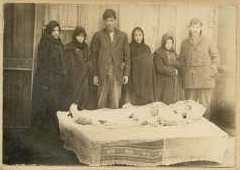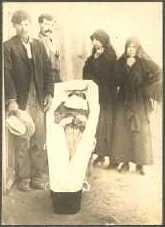Sign up for the Family Tree Newsletter Plus, you’ll receive our 10 Essential Genealogy Research Forms PDF as a special thank you!
Get Your Free Genealogy Forms
"*" indicates required fields
 |
 |
| Figure 1 | Figure 2 |
After Joe Sanchez’s father died, he found these two post-mortem photographs in his belongings. These photographs are a mystery; all Joe knows is that his father was born in Durango, Mexico, in 1913.
At first, it seems unlikely that either of these images will yield any details. Yet by breaking each image down into small researchable pieces, it is possible to tell Joe a little more about his family. Figure 1 is a grieving family gathered around a young girl’s body draped in white with flowers. It is possible the older woman on the far left is the girl’s mother and the rest of the participants her siblings. The body is laid out on a cloth-covered table with no casket visible. Her pose reflects sleep rather than death. In Figure 2, the deceased is an older man, this time in a purchased casket with metal handles. This is not a handmade coffin.
Until 1910, photographs focused on the body, either in the casket or arranged as though sleeping, according to Jay Ruby in Secure the Shadow: Death and Photography in America (MIT Press, $24.95). Occasionally one person or a set of parents flanked the body, but larger groups of people surrounding the deceased didn’t appear in images until after 1910.
You may be disturbed or taken aback by these post-mortem photographs, but they were only meant to memorialize the dead. If the person never had a picture taken when alive, family members often chose to have a picture taken after he died, thus having a permanent memory of their relative. This was quite common with young children and babies. It is unknown why these two images were important to the Sanchez family. Unfortunately, the meaning of the images died with Joe Sanchez’s father. However, family history research might uncover some new information.
Both of these images are signed with a photographer’s imprint of “Read & Shaw, Hurley, NM,” so the first step is to verify that information. The New Mexico Record Center confirmed that Hurley, NM, exists and is located in Grant County. It was named for J.E. Hurley, general manager of the AT&SF Railroad. Hurley is the site of a smelter for an open pit copper mine originally owned by Chino Mines.
So how did these photographs end up in Joe Sanchez father’s collection? It is likely that part of the family immigrated to the United States to work in Hurley’s mines. When two members of the family died, they were photographed and relatives sent the pictures back to Durango.
Sometimes a photographer’s imprint can help date a photograph, but in this case, there is no information about the photographers. Neither the International Museum of Photography at George Eastman House or the photo archive at the Museum of New Mexico has any material on Read & Shaw. It is possible they were itinerant photographers working in the area or that one of them was even the funeral director. A George M. Shaw operated as a photographer in different parts of New Mexico, but there is no paper trail to connect him to Read & Shaw.
Additionally, it is difficult to decipher the clothing clues in these pictures. The only person dressed in contemporary styles is the man on the right in Figure 1, and possibly the same person standing second from the left in Figure 2. He wears his hair parted on the side with a full mustache in a style worn for several decades from the 1880s to circa 1910. But his overcoat in Figure 1 helps narrow the time frame for that image to 1900-1910. The women’s clothing and the other man’s coat are not helpful.
Since these photographs ended up in a family collection, it is very likely that these individuals are related to Joe Sanchez. The key is putting together the family data with the photographic evidence. Step-by-step genealogical research is the best way to link the two together. While it seems certain the photograph dates from the beginning of the 20th century, the owner’s next step is to research his heritage in New Mexico. There are many leads to follow based on the details in these pictures, including the connection to mining in New Mexico, immigration at the turn of the century and religious records that would document the two deaths. Joe Sanchez could use census records to look for Sanchez family members in the Hurley area in the early part of the 20th century. Church documents might provide death dates as well as marriages and births. Diocesan records for the town may be located at the New Mexico State Records Center and Archives, 404 Montezuma, Santa Fe, NM 87503.
If anyone has any additional information on any of the photographs featured in this column, please e-mail me at mtaylor@taylorandstrong.com.
Find out how to submit your own picture for possible analysis by Maureen Taylor. E-mail her at mtaylor@taylorandstrong.com.
ADVERTISEMENT

